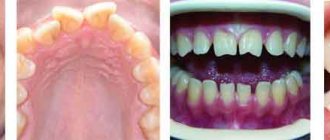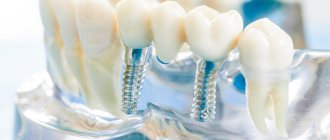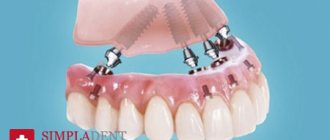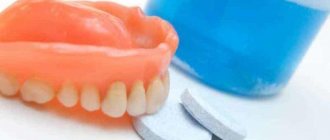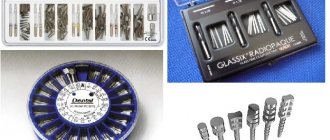In modern dentistry, there are many different methods for restoring damaged teeth - filling, prosthetics, installing inlays. The first two technologies are well known to patients, but few people know that teeth can be successfully restored with inlays.
What are tooth inlays, how do they differ from regular fillings, and in what cases is the use of inlays indicated? We will answer all these questions in detail in this article on our website.
What is it - a tooth tab?
Dental inlays are microprostheses that can be used for different purposes. Restorative or restorative inlays are used like fillings: they help recreate the natural crown of a tooth, keeping it alive. Stump inlays are used in cases where it is necessary to restore a badly damaged tooth under a crown. Let's take a quick look at why restoration and stump inlays are used, and find out the difference between them.
Restoring inlays are stronger than conventional dental fillings and differ from them in the technology of their creation: dental inlays are not made directly in the patient’s mouth, like fillings, but in a dental laboratory, using previously taken impressions. Because microdentures are made in a laboratory setting, they are also called indirect dental inlays.
The inlays exactly repeat the shape of the cavity that needs to be closed for tooth restoration and fit tightly to the natural tissues. The high density of adhesion of the inlay to the tooth tissue eliminates the risk of developing caries in the gap between the installed microprosthesis and the tooth. Restoring a tooth with an inlay will help keep the tooth alive in a situation where a sufficient amount of tooth tissue has been preserved, its nerve is alive and well, but a large filling still needs to be placed. Large fillings do not stick well to the teeth and can break under stress, along with the tooth. Inlays have a long useful life, can withstand chewing loads well, and their use makes it possible not to rush into dental prosthetics with a crown, which often requires preliminary depulpation of teeth.
Stump inlays for a tooth are no longer a restoration element, but a technical one. It acts as a support for the installation of a dental crown in cases where the tooth cannot be restored qualitatively with a conventional filling. In order not to confuse stump and restoration inlays, the easiest way to classify them is as follows: restorative inlays are installed outside the living tooth, stump inlays are always located under the crown.
This is the main classification of inlays, but they can also differ in the type of material they are made of, and below we will definitely talk about all the types of microprostheses and their features. But first, let's find out who and when is recommended to install inlays on teeth.
Why is an inlay better than a filling?
Inlays are much stronger and more durable than traditional fillings, thanks to the use of reliable materials (composites, ceramics). The service life of a ceramic inlay is 20 - 25 years. Not a single filling is capable of performing its functions efficiently for such a long period.
Dental prosthetics with ceramic inlays protects the tooth from further destruction, since ceramics is a durable material that can withstand any chewing and temperature loads. This is the only option for tooth restoration that helps avoid subsequent pulp removal and crowning. Ceramic inlays have the tightest fit to the living tissues of the tooth, thus minimizing the risk of developing secondary caries.
Indications for dental restoration with inlays
Let's look at all the cases in which the use of tabs may be indicated. It is recommended to use tabs:
- If the tooth is destroyed by more than 1/3;
- With increased wear of chewing teeth;
- When restoring teeth that in the future will have to act as a support for a crown or installation of a bridge;
- For large carious cavities in the teeth, the elimination of which with conventional fillings is ineffective.
The need to use inlays is determined by the dentist during the examination of the patient. Based on the clinical situation, the specialist will choose the type of microprosthesis that is suitable for you, both in terms of functionality and material of manufacture.
Types of stump inlays
Collapsible and non-collapsible
Non-separable is a one-piece structure containing one abutment and 1-2 supports in the channels. Unbendable ones are often made by casting, so they are very strong and durable. They are used to restore teeth with one or two canals.
Collapsible - used in multi-rooted teeth with two or three root canals. The design consists of several pins fixed in the channels. The products are used when, due to the complex anatomical structure of the tooth, it is impossible to cast an inlay. The process of creating and pinning folded cards is more complex, but effective. Therefore, structures are widely used to restore teeth that have been destroyed by more than 50%.
Single-channel and multi-channel
Depending on the number of channels, designs are: single-channel, two-channel, three-channel and four-channel. The latter are used quite rarely; often 2-3 pins are enough to restore even a large molar. Products in 1-2 channels are cast structures made of various materials. Tabs with 3-4 channels are often made foldable. They are made from metal alloys.
Inlays for front and chewing teeth
In the frontal region, the teeth have a root, so single-rooted teeth are used for treatment. The front teeth are visible when smiling and talking, so aesthetic materials are used to make products - ceramics, fiberglass. They are light or transparent, completely hidden from others. Such tabs do not spoil the appearance, do not shine over time and do not cause inconvenience.
Products for chewing teeth can have a different number of pins - from 1 to 4. A variety of materials are used for their manufacture. The choice of design should be made by a specialist, taking into account the wishes of the patient and the individual characteristics of the clinical situation.
Types of restoration dental inlays: description, characteristics
In this section of the article, we will tell you about what restoration dental inlays can be, used in tooth restoration as an alternative to conventional fillings. Prostheses will be classified mainly according to the material of manufacture and according to this criterion, the inlays can be ceramic, composite, or metal. The material of the tooth inlay will affect both the performance characteristics of microprostheses and their cost.
Ceramic tooth inlay and its features
Most often, ceramic dental inlays are used to restore chips on living teeth and act as a high-quality and more reliable alternative to conventional fillings.
Ceramic inlays can only be placed on teeth that are alive, not loose, and have been treated for caries. Ceramic dental inlays have many advantages: they are aesthetically pleasing, durable, do not change their beautiful color even with prolonged use, and do not wear off. The high density of the marginal contact of the ceramic inlay with the natural tissues of the tooth eliminates the risk of developing secondary caries.
But ceramic dental inlays have some disadvantages. Some consider the disadvantages of ceramic inlays for teeth to be the high price of this type of microprosthesis in Moscow (from 8 thousand rubles), however, it should be noted that the high cost is fully justified by the long service life of ceramic inlays and their impeccable aesthetics. Please note that with ceramic inlays installed on your teeth, you will need to give up the habit of chewing nuts, crackers, and other types of too hard foods with your teeth. The ceramic inlay may not withstand such heavy loads!
Metal tooth tab: characteristics, pros, cons
Metal restoration inlays are used quite rarely these days, and all because microprostheses made from this material have a number of disadvantages:
- When installing metal inlays in the mouth, a very unpleasant galvanic side effect for the patient may occur, expressed in constant and profuse salivation, a pronounced metallic taste in the mouth;
- Installing metal inlays does not allow for high-quality and tight contact between the microprosthesis and the natural tissues of the tooth, and this increases the risk of developing secondary caries. Gold inlays on teeth can provide a good fit, but their price will be high, because gold is a noble and expensive metal;
- Metal inserts can cause allergic reactions;
- The aesthetics of metal inlays also leaves much to be desired.
The only significant advantage of metal inlays for teeth is the fairly low price for this type of microprosthesis in Moscow. The cost of a metal tab in the capital’s clinics starts at 4,000 rubles for one orthopedic product.
Composite inlays for teeth
Composite inlays are used to restore single-rooted teeth, which include incisors and canines, that is, the front teeth included in the smile area.
Installation of a composite inlay can only be carried out if the tissue in the tooth being restored is preserved in a volume of at least 50%. Composite inlays are also called pin inlays because when they are placed in the tooth canal, a pin is first placed on which the dentist will apply the composite material in layers. If the tooth is severely damaged, installing an inlay on a pin is not recommended, since over time the pin may begin to wobble in the tooth canal and its mobility can lead to a fracture of the tooth root. If your tooth is more than half destroyed, you do not need a restoration, but a stump inlay followed by installation of a crown!
How much will a composite tooth inlay cost? The answer to this question will depend on what type of post and composite material the dentist uses during the restoration process.
The price of a restoration insert will also depend on the method of its manufacture. All inlays, except composite ones, are created in the laboratory using dental impressions. The tooth for the inlay must be ground down, although the volume of tissue removed will be less than the amount of dental tissue that is removed for the crown. The most complex manufacturing technology is for ceramic crowns, which are made from pressed ceramics: they are created using CAD/CAM computer technology. The complexity of the technology increases the price of ceramic inlays, but such microprostheses will have high anatomical accuracy, which means they will last longer.
Materials for manufacturing stump inlays
- Metal stump tab. The metal abutment inlay can be made of an alloy of chromium and cobalt, there are also inlays in a silver abutment and inlays in a gold abutment. They are reliable, but not aesthetically pleasing, which is why in modern dentistry gold supporting inlays and silver microprostheses are used quite rarely and only for chewing dentures.
- Metal-ceramic liner. A metal-ceramic abutment inlay is quite durable, but its quality is worse than that of inlays made from other materials due to the difference in the thermal expansion of metal and ceramic. Therefore, such microprostheses often fall out.
- Ceramic inlay. The ceramic abutment insert best preserves the aesthetics of a smile, since ceramics in its properties and appearance are as close as possible to natural tooth enamel. Therefore, the abutment tongue on the front tooth is made from this material.
- Zirconium stump inlay. The advantage of such structures lies not only in their high strength, but also in the white color of the abutment insert made of zirconium dioxide, which is not visible through the crown. Therefore, as an answer to the question “Which abutment inlays are better?” Together with a ceramic inlay, we can safely call an oxide or zirconium dioxide inlay a pin. Therefore, the anterior tooth stump can also be made of zirconium.
- Composite stump inlay. The type of inlay is suitable for a stump with a pin, which adheres better to the tooth tissue than others, but is not strong enough compared to inlays made from other materials.
How are restoration inlays installed on teeth?
Installing a restorative inlay on teeth is a multi-step process that always begins with a detailed diagnosis, which will include examination, radiography and computed tomography. After the diagnosis, the type of inlay is selected and a detailed treatment plan is drawn up.
The tooth on which the inlay is planned to be placed is ground down and then an impression is taken from it and sent to a dental laboratory. An inlay will be made based on the impression and the average production time is 5-7 days.
When the inlay is ready, the patient is invited to the clinic for fitting and installation of a microprosthesis. The inlay is fixed in the tooth cavity using special dental cement.
How does deletion work?
Before removing the broken wall, it is necessary to undergo an examination. To assess the degree of tooth decay and create a treatment plan, the doctor conducts a visual and instrumental examination, and then sends the patient for an x-ray.
Removal steps:
- Hygienic treatment. The process involves thoroughly cleaning adjacent teeth from plaque and stones. After this, the oral cavity is treated with antiseptic agents.
- Anesthesia. Removal of a damaged tooth is carried out under local anesthesia. To do this, the doctor first treats the injection site with a special spray with a freezing effect, and then injects an anesthetic.
- Delete. For minor damage, forceps are used. Even if the roots remain under the gum, the doctor will be able to grab them and remove them. In the case of a crumbled tooth, a special tool is used to the very base - an elevator.
- Elimination of foci of inflammation. Often, when a rotten tooth is removed, inflammation is detected. To avoid complications during the healing process, the lesions are carefully treated with antiseptics and anti-inflammatory agents.
- Stitching. When removing the root, the doctor separates flaps of soft tissue and then applies stitches to help the wound heal faster.
The average duration of the procedure for simple removal is about 20 minutes. If the tooth is severely crushed, the time may increase to 30 minutes or more.
Is it possible to put an inlay on the front teeth?
Inlays are not used for the restoration of anterior teeth. If there is a sufficient amount of healthy tooth tissue, the tooth is restored with a regular filling and then a veneer or lumineer can be placed on it to obtain a beautiful aesthetic restoration in the smile area. If the tooth is severely damaged, then it makes sense to install a stump tab and then a crown.
The traditional area of application for restoration inlays is chewing teeth.
Removing a pin from a canal: risks and features
The method of removing the pin from the canal is also determined individually. First of all, it depends on the material from which the structure is made: gutta-percha and fiberglass pins are removed by drilling with special threaded needles. But titanium structures are grabbed with a special clamp and twisted as carefully as possible, trying not to damage the root. Other factors to consider when choosing a method for removing a post from a tooth:
- Type of endodontic structure;
- Material for fixing it in the root canal;
- Position of the problem unit in the dentition;
- Risk of complications;
- The thickness of the walls of the canal and the crown of the tooth.
As a rule, it is easiest to remove the core tab and pin from the frontal teeth. As for premolars and molars, everything is much more complicated here: even the choice of instruments is seriously limited... The fragility and thinness of the dental walls play a role, which significantly complicates the repeated procedure. There is a high risk of root perforation or fracture, which are always associated with complete loss of the unit.
If the pin was secured inside with cement or composite, it is recommended to use ultrasonic waves, thanks to which they can be removed without affecting the dental tissue. This is especially true, because after removing the tab, you can avoid tooth extraction only by maintaining its functionality. Moreover: a good prognosis for this must be long-term. Otherwise, it is better to immediately remove the entire unit along with the orthopedic structure.
The dentist’s standard algorithm for removing the pin is as follows:
- Removing the main volume of material with which it is secured in the root canal;
- Carefully removing its residues using ultrasonic waves;
- Removing the pin structure using a special endodontic clamp;
- X-ray of the tooth to monitor treatment and identify fragments that broke off during the removal of the pin.
Can a tooth get sick under an inlay and what to do if this happens?
If the tooth under the inlay hurts, you need to urgently contact a dental clinic, because pain under the installed microprosthesis can indicate the development of various kinds of complications. The main cause of complications after installing an inlay is medical errors that were made during the treatment process, and that is why it is so important to choose dentistry carefully! If, when treating a tooth, the doctor allows the pulp to overheat, an inflammatory process may begin, as a result of which the tooth under the tab will become sore. To eliminate pulpitis, you will have to remove the tooth inlay, receive appropriate treatment, and then restore the tooth again, possibly with a prosthetic crown or even implantation.
Inlays are often placed on teeth after caries treatment and it is extremely important that when working with a carious cavity, the dentist removes all destroyed tissue. If this is not done, secondary caries will begin under the tab, the treatment of which will again require removal of the tab.
Remember that if 5-7 days have passed after installing the inlay on the tooth, and your tooth hurts and the intensity of the pain is increasing, you need to urgently see a dentist, and not try to solve the problem yourself! If the infection gets into the root part of the tooth, it is not always possible to save the tooth and avoid its removal!
If the tooth does not hurt, but you have the feeling that it is bothering you - when eating, talking, trying to close your teeth - contact the clinic where you received the inlay to have its size corrected.
How is the tab made?
At the MediLine dental clinic, a high-tech CEREC hardware complex is used to make inlays. It allows you to scan the damaged cavity, model the inlay individually for each patient and, based on the prototype, turn it out of a single block of ceramics. Next, the tab is fired in a special oven and only then fixed to the tooth. Everything ingenious is simple!
Stump inlays: what do you need to know about them?
At the very beginning of our article, we said that stump inlays should not be confused with restorative microprostheses - they are used to restore pulpless and severely damaged teeth, in which they will serve as the basis for installing a crown or dental bridge.
Stump inlays are structures consisting of two parts: a pin installed in the root canal and a support on which the crown will be fixed. Stump inlays can be monolithic or collapsible, and most often this type of structure is used when the tooth has less than 50% of healthy tissue left.
Many people are interested in the question: why is it best to use core inlays rather than fillings on a pin to restore severely damaged teeth? The fact is that the pin may not withstand the load and begin to wobble in the canal, and this will either lead to the filling breaking or falling out, or, worst of all, to damage to the tooth root, in which the tooth is most often removed. Stump inlays allow you to avoid such risks because they distribute the load more correctly and themselves have much greater strength compared to pins.
Stump inlays are also made in the laboratory and the construction material is selected to match the type of dental crown that is planned to be placed in the future. Metal core inlays are used for metal-ceramic crowns, and zirconium inlays are used for ceramic crowns. If you make a metal inlay for a ceramic crown, it can shine through the thin and transparent material of the crown, which will have a bad effect on the aesthetics of the restoration.
Tooth restoration using a core inlay will also be divided into several stages: diagnostics, preparation, during which a cavity is formed in the tooth for the inlay, manufacturing of the inlay, and its installation. After installing the core tab, the crown is fixed on it and this completes the process of tooth restoration.
If the tooth is destroyed, but there is a living nerve in it, before installing the stump tab, depulpation is carried out, as well as treatment and filling of the root canals. It is important that these procedures are carried out without errors, since poor canal processing leads to various kinds of complications, the elimination of which requires complex and lengthy treatment.
Manufacturing technology of stump inlays
- Layering ceramics. After receiving the impressions, a refractory model is made, a ceramic pin is firmly installed in the canal, ceramic is applied and fired. In the process of applying ceramic layers, you can choose different colors and shades of material, dyes and modifiers.
- Production of ceramics by pressing from tablet molds. The liner is modeled from wax, the sprues are installed in the direction of the ceramic flow. Using a silicone ring, a lining material is inserted and a limiter is placed. Pressing takes place in an oven equipped with a microprocessor control system. The resulting product after pressing and casting is a solid single crystal, the abrasion of which is comparable to the natural abrasion of hard tooth tissues.
- Manufacturing using CAD/CAM method. Allows you to create prostheses and parts that match the implant, abutment, and abutment shape. The device is scanned in the oral cavity or on a model, 3D modeling is performed using a special program, the information received is transferred to a drill, which mills the product under computer control. An accurate and sophisticated method that requires high costs for professional training of personnel to operate the equipment.
- Injection molding method. Casting a working model from plaster / polyurethane, choosing an ashless pin according to the type of root canal, applying silicone varnish to the root. The pin is inserted into the canal and an ashless plastic/wax modeling is performed. After a control check, the cast abutment inlay is removed and transferred to a metal casting. The method is technologically advanced, economical, requires a minimum of material costs, but is very sensitive to the quality of the casting. With strict adherence to all norms and rules, reliable and high-quality microprostheses are obtained.
Tab lifespan
The service life of restoration inlays will depend on the material and production technology of microprostheses, as well as on how accurately the patient follows the dentist’s recommendations. Composite inlays last about 5-7 years, ceramic inlays - up to 20 years. This is subject to high-quality dental and oral hygiene and regular visits to the clinic for preventive examinations.
Stump inlays can last you a lifetime, and crowns on them last up to 15-20 years.
Do you still have questions about restorative and core dental inlays? Ask them to the orthopedists of our dentistry in Moscow - Vanstom! You can make an appointment with the clinic’s doctors at any time convenient for you - through the chat on our website, the call back form, or simply by dialing the contact phone number!
Treatment technology: how to install inlays
First visit: during the initial examination, the condition of the teeth and oral cavity as a whole is examined. The carious cavity must be removed, if necessary, the nerve of the tooth is cleaned, and the canals are filled. After preparing the cavity, impressions are taken and sent to the dental laboratory. Impressions are taken of at least two teeth – the one being restored and the opposite one. This is necessary so that the restored tooth does not “stick out” and does not interfere with the closure of the jaws. Next, the patient will have a temporary filling installed.
Second visit: the temporary filling is removed and the inlay is tried on. If it fits perfectly and does not cause discomfort to the patient, it is fixed with permanent dental adhesive cement. Its excess is removed and the surface is polished.
Advantages of inlays over fillings
- a more durable option for prosthetics, since a large filling simply cannot withstand the load and falls out - the inlays are fixed stronger and more reliably,
- the risk of developing caries under the inlay is minimized - the microprosthesis fits more tightly, there are no micro-cracks through which bacteria and food debris get under the inlay,
- the tab retains its color and shape even after decades,
- the color is selected as accurately as possible to match the shade of the tooth,
- the inlay can be used to build up and strengthen the tooth for further prosthetics (for example, a crown, bridge or removable denture),
- there is no need to remove the nerve of the tooth if it is not inflamed.
Disadvantages of Tabs
Inlays are a more expensive type of prosthetics compared to conventional tooth filling, since in addition to the dentist-therapist, an orthopedist and a dental technician are also involved. In addition, inlays are made from more expensive materials and it takes much longer to restore a tooth - at least two visits.
Indications and contraindications.
Installing a ceramic inlay requires two visits to the dentist. The first, in which the doctor examines the patient's oral cavity, evaluates the possibility of restoration and takes an impression, from which the technician will make a plaster model for the restoration. The tooth is first restored on a model and then the inlay is installed on the tooth. At the first appointment, the doctor explains in detail how the restoration will be carried out, what procedures need to be done, and what the cost of restoration will be for a particular patient. The second visit is accompanied by fitting and evaluation of the technician’s work - how well the inlay matches the color, transparency and shape of the living tooth, how it interacts with neighboring teeth, and whether it causes discomfort to the patient. After this, the tab is glued to the tooth. It should be understood that a ceramic inlay is installed only according to a doctor’s indications. Quite often, if possible, a crown is not placed, and restoration is carried out using inlays. Among the many advantages of a ceramic inlay, it is worth mentioning that plaque does not settle on it, over time the inlay does not fade or change color, in addition, the inlay does not irritate the soft tissues of the oral cavity. Ceramic inlays are ideally combined with tooth enamel and do not contain micropores, which guarantees the absence of detachments from the walls. After restoration of the front teeth with ceramic inlays, the teeth look natural. The main indications for installing a ceramic inlay include significant damage to the tooth when restoration with a filling is impossible. If the tooth is partially preserved, an inlay can preserve the natural tooth. If we talk about comfort, it is worth noting that the inlays do not require additional care; it is necessary to maintain regular personal hygiene, conduct preventive examinations at the dentist and promptly treat any problems that arise. As for contraindications to the installation of a ceramic inlay, it is worth highlighting the presence of such factors in the patient as a shallow cavity depth, bruxism, insufficient personal hygiene, high caries activity, the presence of steep bevels of the cusps, and an approximal cavity extending deep into the dentin. In addition, it should be understood that if a wisdom tooth requires restoration, installing an inlay on it is impractical, since such a tooth does not bear the chewing load. When a wisdom tooth is destroyed, its removal is most often indicated.




